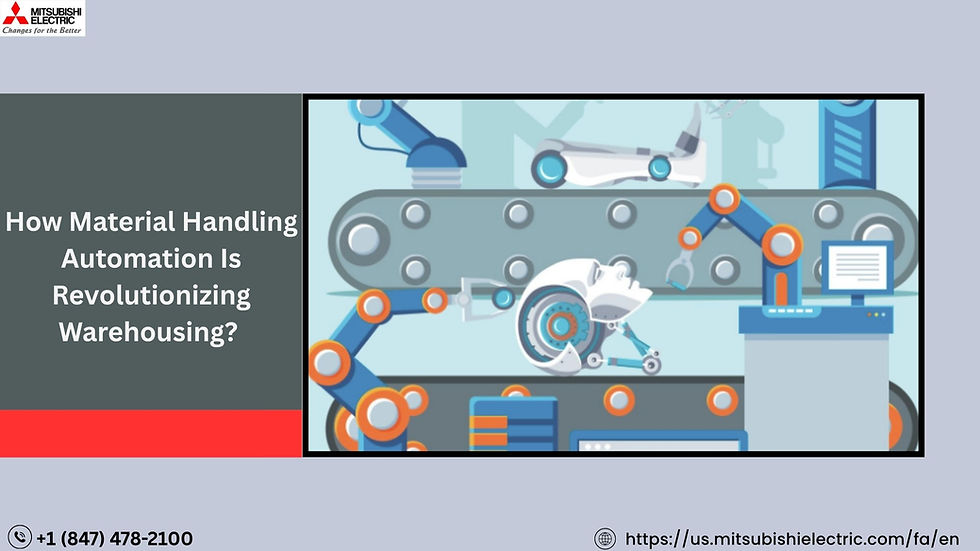How Material Handling Automation Is Revolutionizing Warehousing?
- mitsubishielectric1
- Jul 23
- 4 min read

The warehousing and logistics industry is undergoing a rigorous change - thanks to all automation. As the consumer demands rapid and lack of labor, businesses are moving towards material handling automation to improve rapid throughput, reduce human error, and remain competitive in the rapidly increasing market.
This change can move the goods intelligently, fast and more efficiently in the heart. From conveyor system automation to robotic palatizing and smart inventory tracking, automation is how the warehouses are operated from the ground.
The Increased Demand for Warehouse Automation
Warehouses are no longer static storage facilities - they're dynamic hubs that are the spine of global supply chains. With e-commerce on the rise and next-day delivery becoming the norm, the demand for real-time movement of stock and seamless fulfillment has never been greater.
Manual processes - which were once sufficient - are now constraints that limit scalability. Picking errors, poorly designed facilities, and flaky labor availability are only a few of the many problems faced by conventional warehouses. This is where material handling automation steps in to make life easier.
What Is Material Handling Automation?
It refers to the mechanization of machines, robots, and software to move, store, and retrieve merchandise in a warehouse or a distribution facility. It eliminates the need for manual labor to execute functions like moving stock, sorting merchandise, loading and unloading products, and order pick-up.
Some of the key technologies that fall under the canopy of material handling automation include:
Automated storage and retrieval systems (AS/RS).
Robotic palletizers and depalletizers.
Automated guided vehicles (AGVs) and autonomous mobile robots (AMRs).
Automation of conveyor systems.
Pick-to-light and voice picking technologies.
All of these tools operate together to produce a streamlined, efficient, and highly responsive warehouse environment.
Conveyor System Automation: The Backbone of Material Movement
One of the broadest forms of automation used today is conveyor system automation. This type of system transports materials smoothly between different regions of a building, which reduces labor and transit time to a great extent.
Today's conveyor system has smart sensors, enabling IOT and software control that allows them to adapt in real time to fluctuate process flow. Due to the delay, the automation of the conveyor system is important for the movement of the conveyor system from one chit to another.
The advantages of automated conveyor systems are:
Increased efficiency: Streamlined, uninterrupted material throughput.
Reduced labor cost: Reduced reliance on human carriage and handling.
Increased precision: Practically no possibility of product damage or loss.
Greater scalability: Easily scalable to increasing operations.
In volume fulfillment centers, conveyor systems may be integrated with barcode scanners, sorters, and automated picking gear to create a continuous, hands-free handling process.
Real-World Benefits of Material Handling Automation
Implementing material handling automation isn't simply a matter of substituting labor - it's a matter of rethinking operational strategy. These are just some concrete ways automation is revolutionizing warehousing:
Increased Throughput: Automatic systems can run 24/7 without tiredness, increasing the number of accessories processed daily by several orders of magnitude. It enables godowns to get tight distribution programs and grow without more labor.
Error Reduction: With frequent tasks such as picking, sorting and advancing automated, businesses decrease significant error. Customers' satisfaction is increased, but the returns and inventory versions on significant cost savings are reduced.
Enhanced Safety: Hand content handling includes heavy lifting, repetitive movement, and forklift traffic - the root cause of workplace injury. Automation eliminates these hazards and promotes a healthy task environment.
Better Use of Space: Robotic systems are capable of handling tight spaces and vertical rooms, allowing more class spaces in the warehouse. The AS/RS system, for example, can safely keep goods in high-density layouts that humans can’t safely reach.
Overcoming the Challenges
While the benefits are self-evident, the costs of automation come with material handling. High upfront costs, integration complexity, and resistance from personnel are common impediments. But many of these might be overcome with proper planning and change management.
For example, starting with scalable systems like conveyor system automation or robot picking solutions allows businesses to catch on without overextending budgets. In addition, retraining employees to collaborate with automation can assist in enhancing motivation and reducing job loss anxiety.
The Future Is Fully Automated
With each passing day, technology is becoming more powerful and sophisticated, and this will keep increasing the power of material handling automation. AI systems, machine learning, and predictive analytics are already being integrated in a bid to facilitate improved decision-making and performance. Cloud-based platforms and digital twins are also giving real-time visibility and control at a global level.
Automation is no longer an option for businesses planning to future-proof their warehouse operation - it is a necessity.
Conclusion
The warehousing industry is in the throes of a technological revolution, and material handling automation is leading the way. From increased efficiency to enhanced accuracy and safety, automated systems - and conveyor system automation in particular - are enabling warehouses to stay ahead of today's needs without shutting down.
Whether you're operating a small distribution center or a large fulfillment center, investing the right money in automation technology today will make your operation a success tomorrow.

.png)



Comments